MG414 Organisational Behaviour: Apple's Culture and Effectiveness
VerifiedAdded on 2023/03/17
|11
|2461
|53
Report
AI Summary
This report examines Apple Inc.'s organizational culture, focusing on its creative innovation culture developed by Steve Jobs. It explores how this culture promotes internal communication, employee motivation through rewards and recognition, and overall organizational effectiveness. The report analyzes how Apple's culture fosters innovation, protects intellectual property through secrecy, and drives the company's success in a competitive market. It also evaluates the impact of this culture on communication and employee motivation, suggesting strategies for Apple to further enhance its future success through sustainability and employee empowerment. The analysis considers motivational theories like Theory X and Theory Y, and Maslow's hierarchy of needs, to understand how Apple can continue to leverage its culture for competitive advantage.
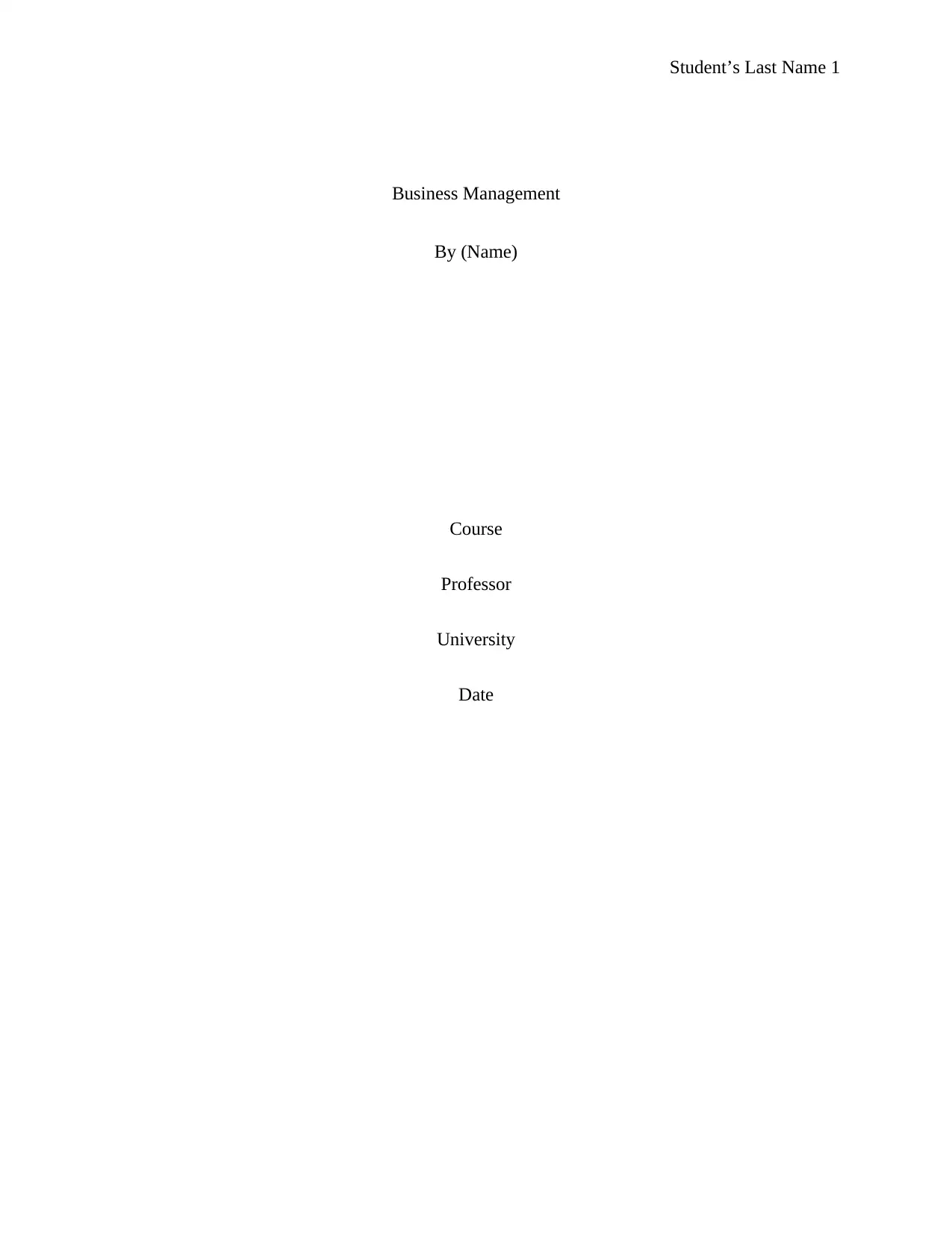
Student’s Last Name 1
Business Management
By (Name)
Course
Professor
University
Date
Business Management
By (Name)
Course
Professor
University
Date
Paraphrase This Document
Need a fresh take? Get an instant paraphrase of this document with our AI Paraphraser
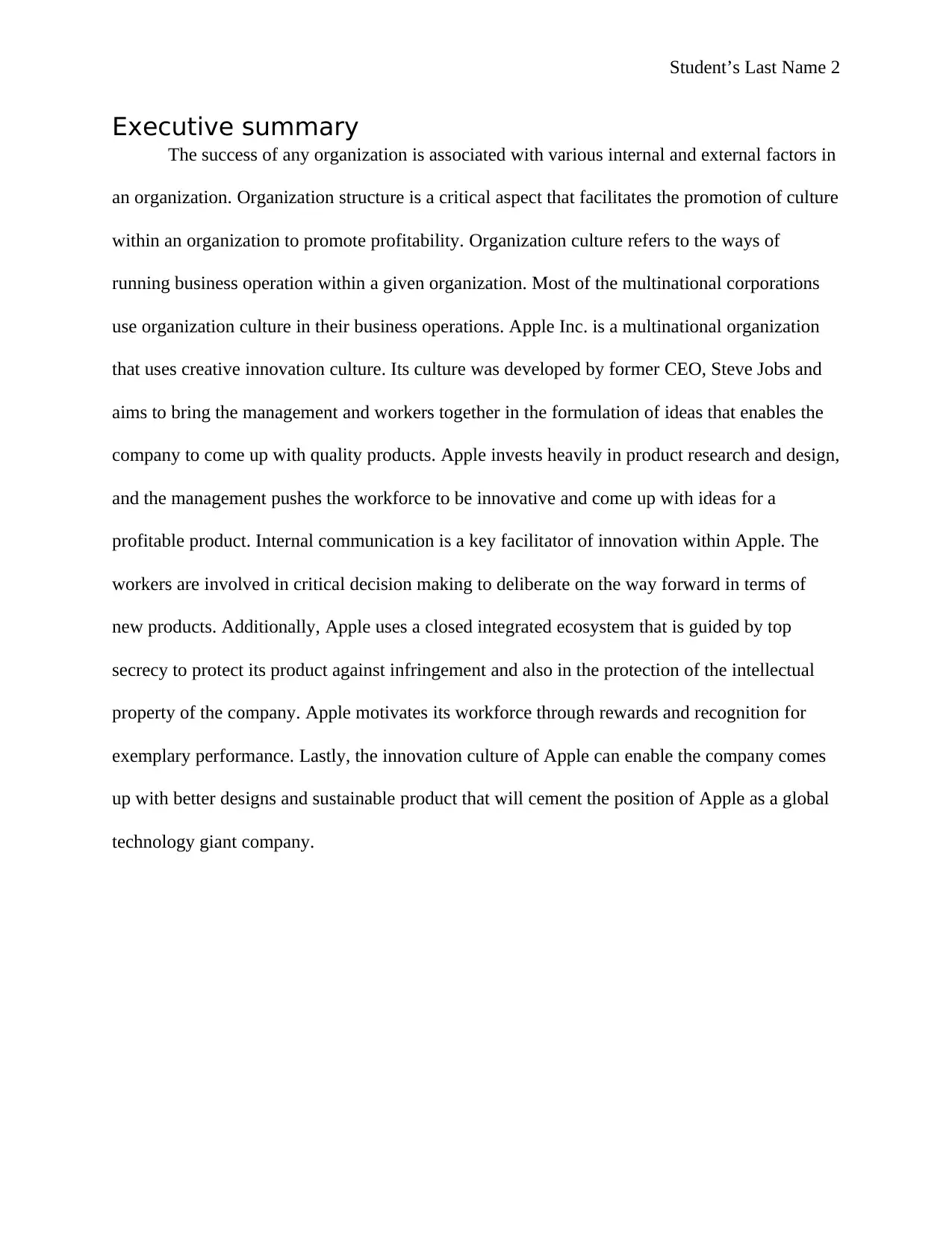
Student’s Last Name 2
Executive summary
The success of any organization is associated with various internal and external factors in
an organization. Organization structure is a critical aspect that facilitates the promotion of culture
within an organization to promote profitability. Organization culture refers to the ways of
running business operation within a given organization. Most of the multinational corporations
use organization culture in their business operations. Apple Inc. is a multinational organization
that uses creative innovation culture. Its culture was developed by former CEO, Steve Jobs and
aims to bring the management and workers together in the formulation of ideas that enables the
company to come up with quality products. Apple invests heavily in product research and design,
and the management pushes the workforce to be innovative and come up with ideas for a
profitable product. Internal communication is a key facilitator of innovation within Apple. The
workers are involved in critical decision making to deliberate on the way forward in terms of
new products. Additionally, Apple uses a closed integrated ecosystem that is guided by top
secrecy to protect its product against infringement and also in the protection of the intellectual
property of the company. Apple motivates its workforce through rewards and recognition for
exemplary performance. Lastly, the innovation culture of Apple can enable the company comes
up with better designs and sustainable product that will cement the position of Apple as a global
technology giant company.
Executive summary
The success of any organization is associated with various internal and external factors in
an organization. Organization structure is a critical aspect that facilitates the promotion of culture
within an organization to promote profitability. Organization culture refers to the ways of
running business operation within a given organization. Most of the multinational corporations
use organization culture in their business operations. Apple Inc. is a multinational organization
that uses creative innovation culture. Its culture was developed by former CEO, Steve Jobs and
aims to bring the management and workers together in the formulation of ideas that enables the
company to come up with quality products. Apple invests heavily in product research and design,
and the management pushes the workforce to be innovative and come up with ideas for a
profitable product. Internal communication is a key facilitator of innovation within Apple. The
workers are involved in critical decision making to deliberate on the way forward in terms of
new products. Additionally, Apple uses a closed integrated ecosystem that is guided by top
secrecy to protect its product against infringement and also in the protection of the intellectual
property of the company. Apple motivates its workforce through rewards and recognition for
exemplary performance. Lastly, the innovation culture of Apple can enable the company comes
up with better designs and sustainable product that will cement the position of Apple as a global
technology giant company.
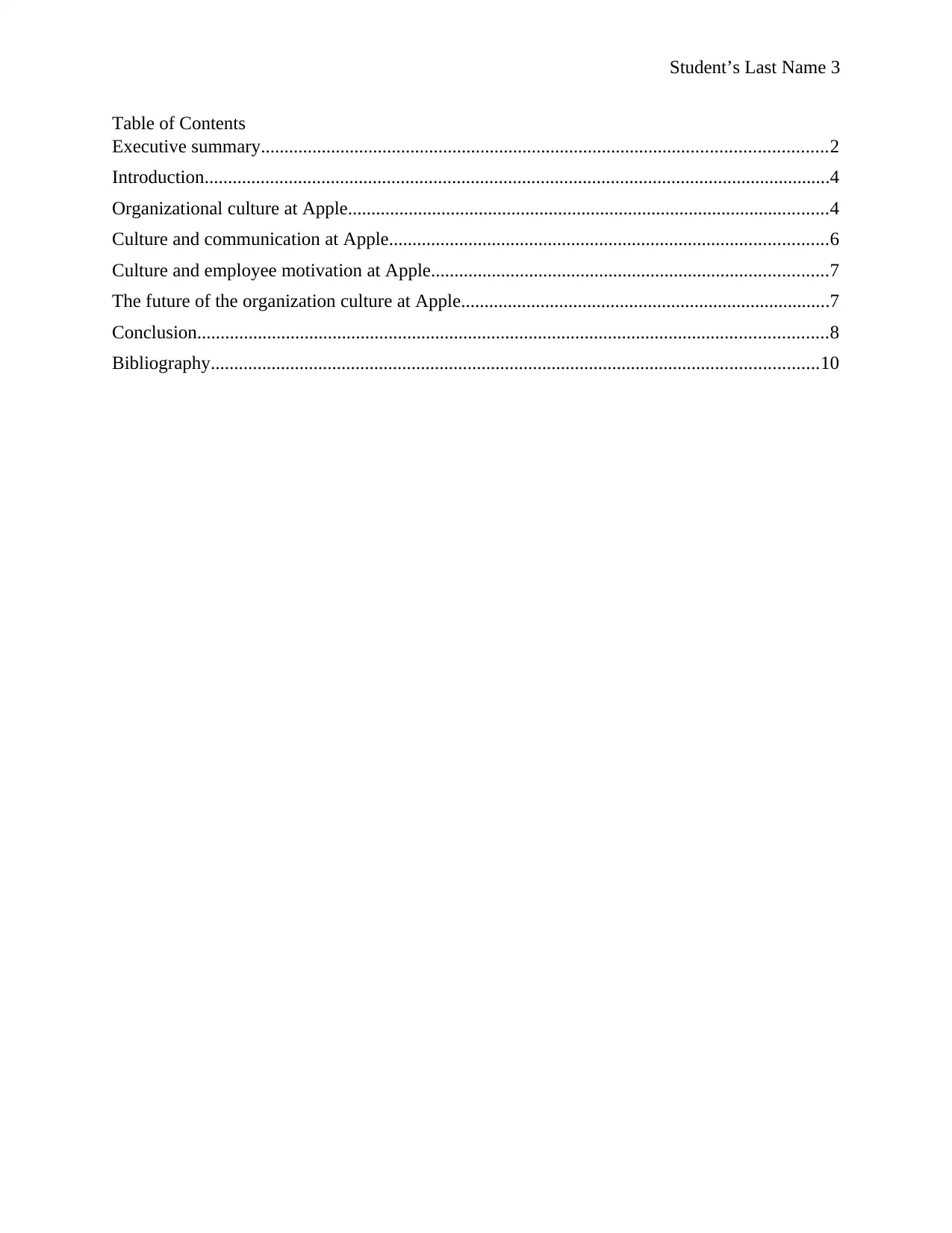
Student’s Last Name 3
Table of Contents
Executive summary.........................................................................................................................2
Introduction......................................................................................................................................4
Organizational culture at Apple.......................................................................................................4
Culture and communication at Apple..............................................................................................6
Culture and employee motivation at Apple.....................................................................................7
The future of the organization culture at Apple...............................................................................7
Conclusion.......................................................................................................................................8
Bibliography..................................................................................................................................10
Table of Contents
Executive summary.........................................................................................................................2
Introduction......................................................................................................................................4
Organizational culture at Apple.......................................................................................................4
Culture and communication at Apple..............................................................................................6
Culture and employee motivation at Apple.....................................................................................7
The future of the organization culture at Apple...............................................................................7
Conclusion.......................................................................................................................................8
Bibliography..................................................................................................................................10
⊘ This is a preview!⊘
Do you want full access?
Subscribe today to unlock all pages.

Trusted by 1+ million students worldwide
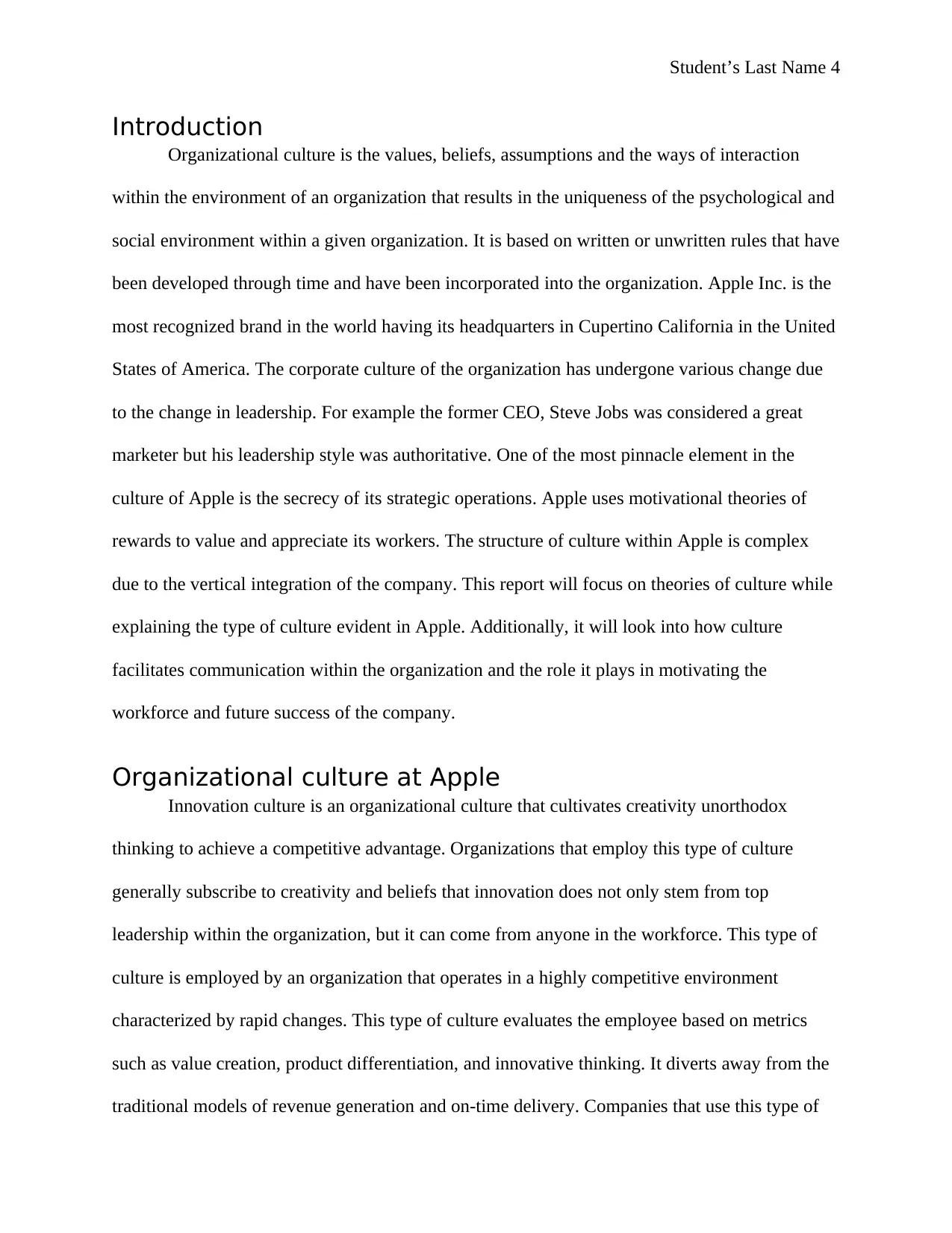
Student’s Last Name 4
Introduction
Organizational culture is the values, beliefs, assumptions and the ways of interaction
within the environment of an organization that results in the uniqueness of the psychological and
social environment within a given organization. It is based on written or unwritten rules that have
been developed through time and have been incorporated into the organization. Apple Inc. is the
most recognized brand in the world having its headquarters in Cupertino California in the United
States of America. The corporate culture of the organization has undergone various change due
to the change in leadership. For example the former CEO, Steve Jobs was considered a great
marketer but his leadership style was authoritative. One of the most pinnacle element in the
culture of Apple is the secrecy of its strategic operations. Apple uses motivational theories of
rewards to value and appreciate its workers. The structure of culture within Apple is complex
due to the vertical integration of the company. This report will focus on theories of culture while
explaining the type of culture evident in Apple. Additionally, it will look into how culture
facilitates communication within the organization and the role it plays in motivating the
workforce and future success of the company.
Organizational culture at Apple
Innovation culture is an organizational culture that cultivates creativity unorthodox
thinking to achieve a competitive advantage. Organizations that employ this type of culture
generally subscribe to creativity and beliefs that innovation does not only stem from top
leadership within the organization, but it can come from anyone in the workforce. This type of
culture is employed by an organization that operates in a highly competitive environment
characterized by rapid changes. This type of culture evaluates the employee based on metrics
such as value creation, product differentiation, and innovative thinking. It diverts away from the
traditional models of revenue generation and on-time delivery. Companies that use this type of
Introduction
Organizational culture is the values, beliefs, assumptions and the ways of interaction
within the environment of an organization that results in the uniqueness of the psychological and
social environment within a given organization. It is based on written or unwritten rules that have
been developed through time and have been incorporated into the organization. Apple Inc. is the
most recognized brand in the world having its headquarters in Cupertino California in the United
States of America. The corporate culture of the organization has undergone various change due
to the change in leadership. For example the former CEO, Steve Jobs was considered a great
marketer but his leadership style was authoritative. One of the most pinnacle element in the
culture of Apple is the secrecy of its strategic operations. Apple uses motivational theories of
rewards to value and appreciate its workers. The structure of culture within Apple is complex
due to the vertical integration of the company. This report will focus on theories of culture while
explaining the type of culture evident in Apple. Additionally, it will look into how culture
facilitates communication within the organization and the role it plays in motivating the
workforce and future success of the company.
Organizational culture at Apple
Innovation culture is an organizational culture that cultivates creativity unorthodox
thinking to achieve a competitive advantage. Organizations that employ this type of culture
generally subscribe to creativity and beliefs that innovation does not only stem from top
leadership within the organization, but it can come from anyone in the workforce. This type of
culture is employed by an organization that operates in a highly competitive environment
characterized by rapid changes. This type of culture evaluates the employee based on metrics
such as value creation, product differentiation, and innovative thinking. It diverts away from the
traditional models of revenue generation and on-time delivery. Companies that use this type of
Paraphrase This Document
Need a fresh take? Get an instant paraphrase of this document with our AI Paraphraser
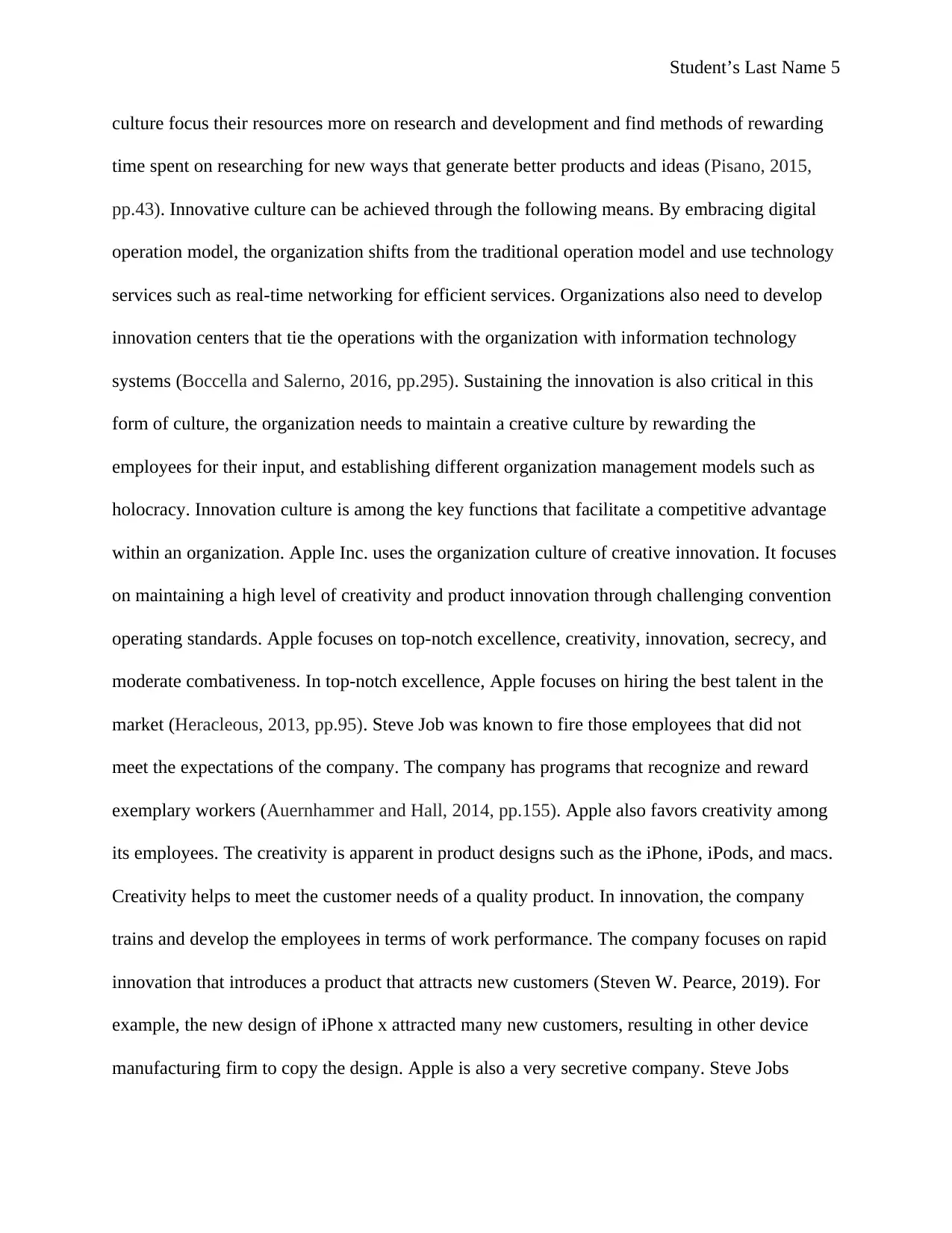
Student’s Last Name 5
culture focus their resources more on research and development and find methods of rewarding
time spent on researching for new ways that generate better products and ideas (Pisano, 2015,
pp.43). Innovative culture can be achieved through the following means. By embracing digital
operation model, the organization shifts from the traditional operation model and use technology
services such as real-time networking for efficient services. Organizations also need to develop
innovation centers that tie the operations with the organization with information technology
systems (Boccella and Salerno, 2016, pp.295). Sustaining the innovation is also critical in this
form of culture, the organization needs to maintain a creative culture by rewarding the
employees for their input, and establishing different organization management models such as
holocracy. Innovation culture is among the key functions that facilitate a competitive advantage
within an organization. Apple Inc. uses the organization culture of creative innovation. It focuses
on maintaining a high level of creativity and product innovation through challenging convention
operating standards. Apple focuses on top-notch excellence, creativity, innovation, secrecy, and
moderate combativeness. In top-notch excellence, Apple focuses on hiring the best talent in the
market (Heracleous, 2013, pp.95). Steve Job was known to fire those employees that did not
meet the expectations of the company. The company has programs that recognize and reward
exemplary workers (Auernhammer and Hall, 2014, pp.155). Apple also favors creativity among
its employees. The creativity is apparent in product designs such as the iPhone, iPods, and macs.
Creativity helps to meet the customer needs of a quality product. In innovation, the company
trains and develop the employees in terms of work performance. The company focuses on rapid
innovation that introduces a product that attracts new customers (Steven W. Pearce, 2019). For
example, the new design of iPhone x attracted many new customers, resulting in other device
manufacturing firm to copy the design. Apple is also a very secretive company. Steve Jobs
culture focus their resources more on research and development and find methods of rewarding
time spent on researching for new ways that generate better products and ideas (Pisano, 2015,
pp.43). Innovative culture can be achieved through the following means. By embracing digital
operation model, the organization shifts from the traditional operation model and use technology
services such as real-time networking for efficient services. Organizations also need to develop
innovation centers that tie the operations with the organization with information technology
systems (Boccella and Salerno, 2016, pp.295). Sustaining the innovation is also critical in this
form of culture, the organization needs to maintain a creative culture by rewarding the
employees for their input, and establishing different organization management models such as
holocracy. Innovation culture is among the key functions that facilitate a competitive advantage
within an organization. Apple Inc. uses the organization culture of creative innovation. It focuses
on maintaining a high level of creativity and product innovation through challenging convention
operating standards. Apple focuses on top-notch excellence, creativity, innovation, secrecy, and
moderate combativeness. In top-notch excellence, Apple focuses on hiring the best talent in the
market (Heracleous, 2013, pp.95). Steve Job was known to fire those employees that did not
meet the expectations of the company. The company has programs that recognize and reward
exemplary workers (Auernhammer and Hall, 2014, pp.155). Apple also favors creativity among
its employees. The creativity is apparent in product designs such as the iPhone, iPods, and macs.
Creativity helps to meet the customer needs of a quality product. In innovation, the company
trains and develop the employees in terms of work performance. The company focuses on rapid
innovation that introduces a product that attracts new customers (Steven W. Pearce, 2019). For
example, the new design of iPhone x attracted many new customers, resulting in other device
manufacturing firm to copy the design. Apple is also a very secretive company. Steve Jobs
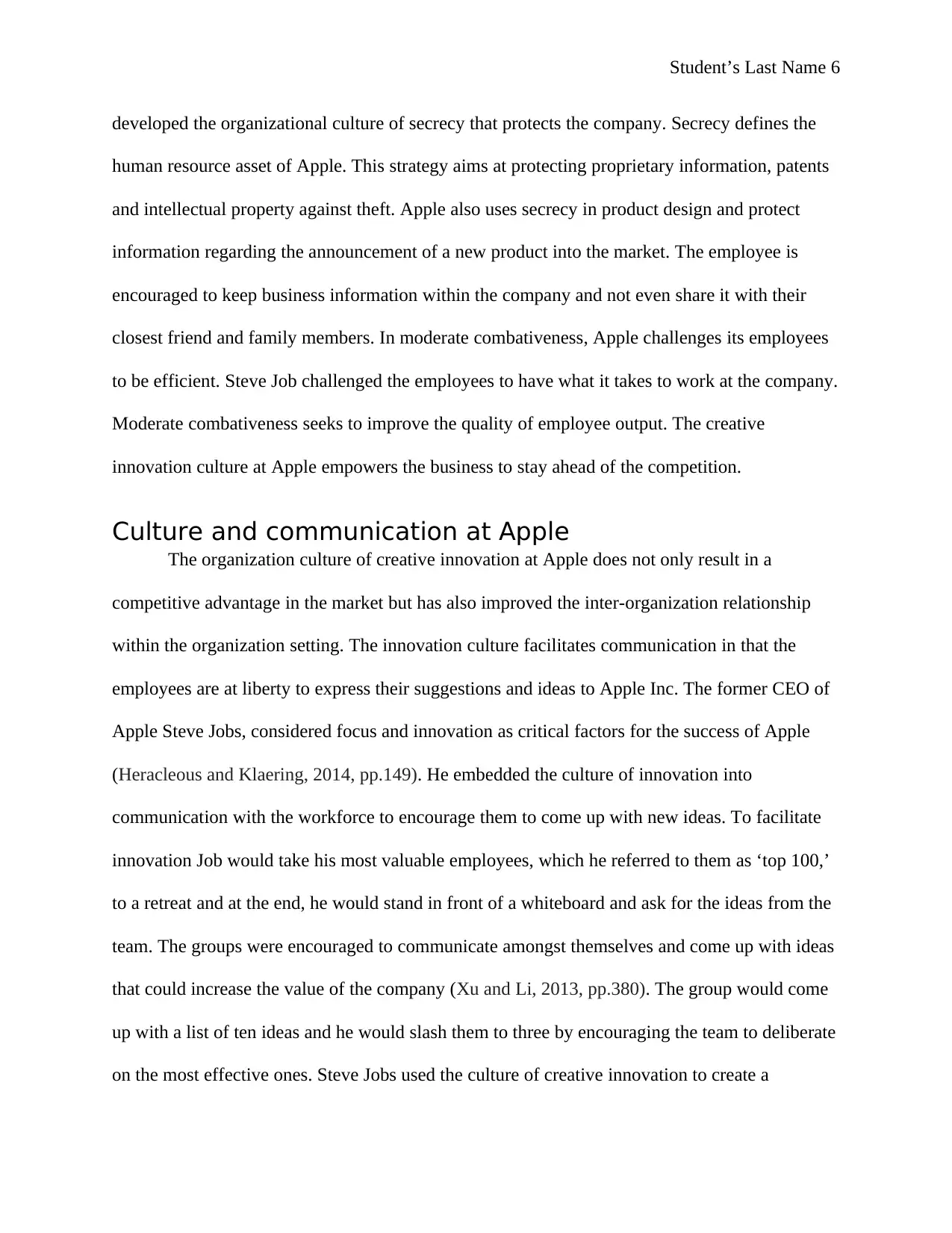
Student’s Last Name 6
developed the organizational culture of secrecy that protects the company. Secrecy defines the
human resource asset of Apple. This strategy aims at protecting proprietary information, patents
and intellectual property against theft. Apple also uses secrecy in product design and protect
information regarding the announcement of a new product into the market. The employee is
encouraged to keep business information within the company and not even share it with their
closest friend and family members. In moderate combativeness, Apple challenges its employees
to be efficient. Steve Job challenged the employees to have what it takes to work at the company.
Moderate combativeness seeks to improve the quality of employee output. The creative
innovation culture at Apple empowers the business to stay ahead of the competition.
Culture and communication at Apple
The organization culture of creative innovation at Apple does not only result in a
competitive advantage in the market but has also improved the inter-organization relationship
within the organization setting. The innovation culture facilitates communication in that the
employees are at liberty to express their suggestions and ideas to Apple Inc. The former CEO of
Apple Steve Jobs, considered focus and innovation as critical factors for the success of Apple
(Heracleous and Klaering, 2014, pp.149). He embedded the culture of innovation into
communication with the workforce to encourage them to come up with new ideas. To facilitate
innovation Job would take his most valuable employees, which he referred to them as ‘top 100,’
to a retreat and at the end, he would stand in front of a whiteboard and ask for the ideas from the
team. The groups were encouraged to communicate amongst themselves and come up with ideas
that could increase the value of the company (Xu and Li, 2013, pp.380). The group would come
up with a list of ten ideas and he would slash them to three by encouraging the team to deliberate
on the most effective ones. Steve Jobs used the culture of creative innovation to create a
developed the organizational culture of secrecy that protects the company. Secrecy defines the
human resource asset of Apple. This strategy aims at protecting proprietary information, patents
and intellectual property against theft. Apple also uses secrecy in product design and protect
information regarding the announcement of a new product into the market. The employee is
encouraged to keep business information within the company and not even share it with their
closest friend and family members. In moderate combativeness, Apple challenges its employees
to be efficient. Steve Job challenged the employees to have what it takes to work at the company.
Moderate combativeness seeks to improve the quality of employee output. The creative
innovation culture at Apple empowers the business to stay ahead of the competition.
Culture and communication at Apple
The organization culture of creative innovation at Apple does not only result in a
competitive advantage in the market but has also improved the inter-organization relationship
within the organization setting. The innovation culture facilitates communication in that the
employees are at liberty to express their suggestions and ideas to Apple Inc. The former CEO of
Apple Steve Jobs, considered focus and innovation as critical factors for the success of Apple
(Heracleous and Klaering, 2014, pp.149). He embedded the culture of innovation into
communication with the workforce to encourage them to come up with new ideas. To facilitate
innovation Job would take his most valuable employees, which he referred to them as ‘top 100,’
to a retreat and at the end, he would stand in front of a whiteboard and ask for the ideas from the
team. The groups were encouraged to communicate amongst themselves and come up with ideas
that could increase the value of the company (Xu and Li, 2013, pp.380). The group would come
up with a list of ten ideas and he would slash them to three by encouraging the team to deliberate
on the most effective ones. Steve Jobs used the culture of creative innovation to create a
⊘ This is a preview!⊘
Do you want full access?
Subscribe today to unlock all pages.

Trusted by 1+ million students worldwide
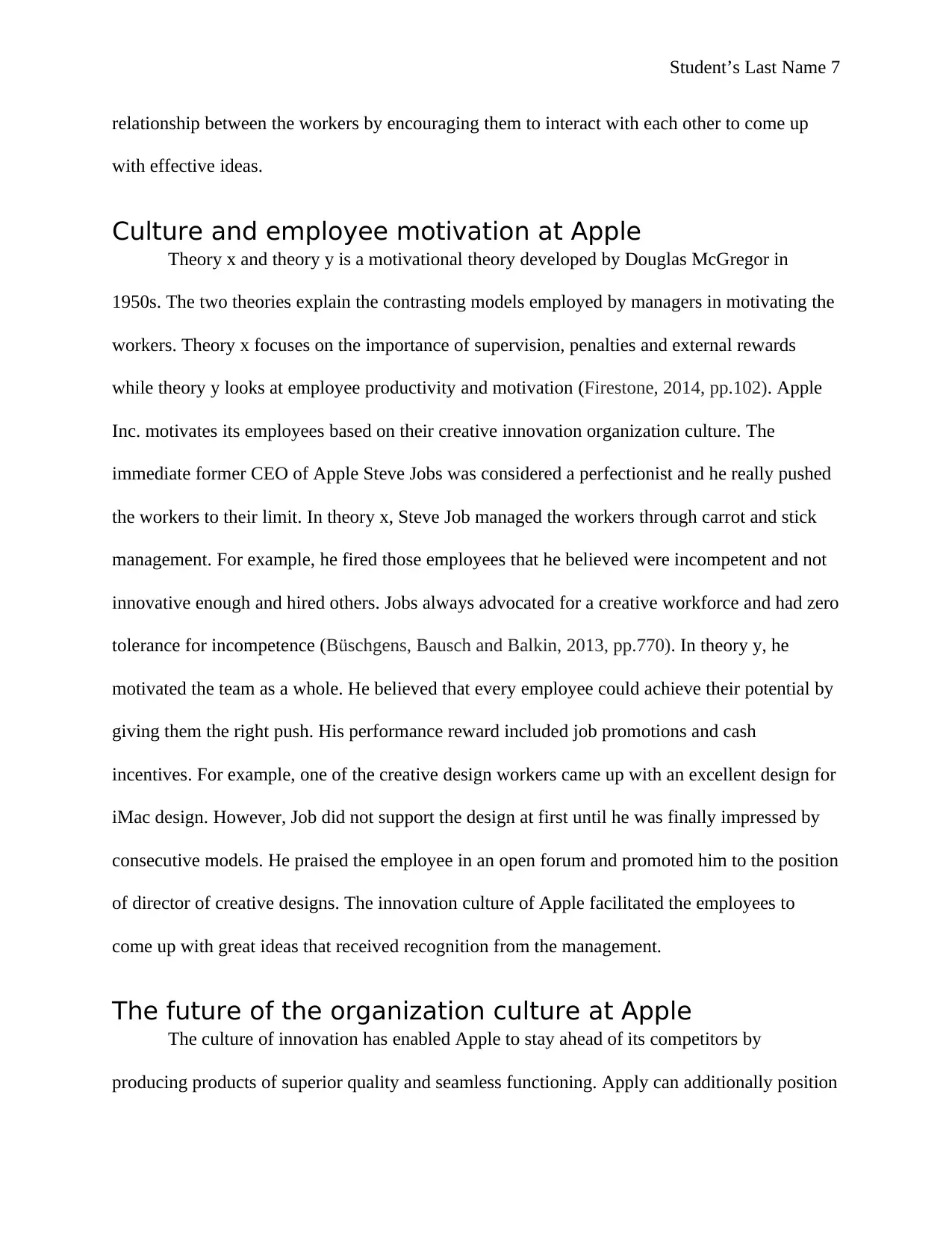
Student’s Last Name 7
relationship between the workers by encouraging them to interact with each other to come up
with effective ideas.
Culture and employee motivation at Apple
Theory x and theory y is a motivational theory developed by Douglas McGregor in
1950s. The two theories explain the contrasting models employed by managers in motivating the
workers. Theory x focuses on the importance of supervision, penalties and external rewards
while theory y looks at employee productivity and motivation (Firestone, 2014, pp.102). Apple
Inc. motivates its employees based on their creative innovation organization culture. The
immediate former CEO of Apple Steve Jobs was considered a perfectionist and he really pushed
the workers to their limit. In theory x, Steve Job managed the workers through carrot and stick
management. For example, he fired those employees that he believed were incompetent and not
innovative enough and hired others. Jobs always advocated for a creative workforce and had zero
tolerance for incompetence (Büschgens, Bausch and Balkin, 2013, pp.770). In theory y, he
motivated the team as a whole. He believed that every employee could achieve their potential by
giving them the right push. His performance reward included job promotions and cash
incentives. For example, one of the creative design workers came up with an excellent design for
iMac design. However, Job did not support the design at first until he was finally impressed by
consecutive models. He praised the employee in an open forum and promoted him to the position
of director of creative designs. The innovation culture of Apple facilitated the employees to
come up with great ideas that received recognition from the management.
The future of the organization culture at Apple
The culture of innovation has enabled Apple to stay ahead of its competitors by
producing products of superior quality and seamless functioning. Apply can additionally position
relationship between the workers by encouraging them to interact with each other to come up
with effective ideas.
Culture and employee motivation at Apple
Theory x and theory y is a motivational theory developed by Douglas McGregor in
1950s. The two theories explain the contrasting models employed by managers in motivating the
workers. Theory x focuses on the importance of supervision, penalties and external rewards
while theory y looks at employee productivity and motivation (Firestone, 2014, pp.102). Apple
Inc. motivates its employees based on their creative innovation organization culture. The
immediate former CEO of Apple Steve Jobs was considered a perfectionist and he really pushed
the workers to their limit. In theory x, Steve Job managed the workers through carrot and stick
management. For example, he fired those employees that he believed were incompetent and not
innovative enough and hired others. Jobs always advocated for a creative workforce and had zero
tolerance for incompetence (Büschgens, Bausch and Balkin, 2013, pp.770). In theory y, he
motivated the team as a whole. He believed that every employee could achieve their potential by
giving them the right push. His performance reward included job promotions and cash
incentives. For example, one of the creative design workers came up with an excellent design for
iMac design. However, Job did not support the design at first until he was finally impressed by
consecutive models. He praised the employee in an open forum and promoted him to the position
of director of creative designs. The innovation culture of Apple facilitated the employees to
come up with great ideas that received recognition from the management.
The future of the organization culture at Apple
The culture of innovation has enabled Apple to stay ahead of its competitors by
producing products of superior quality and seamless functioning. Apply can additionally position
Paraphrase This Document
Need a fresh take? Get an instant paraphrase of this document with our AI Paraphraser
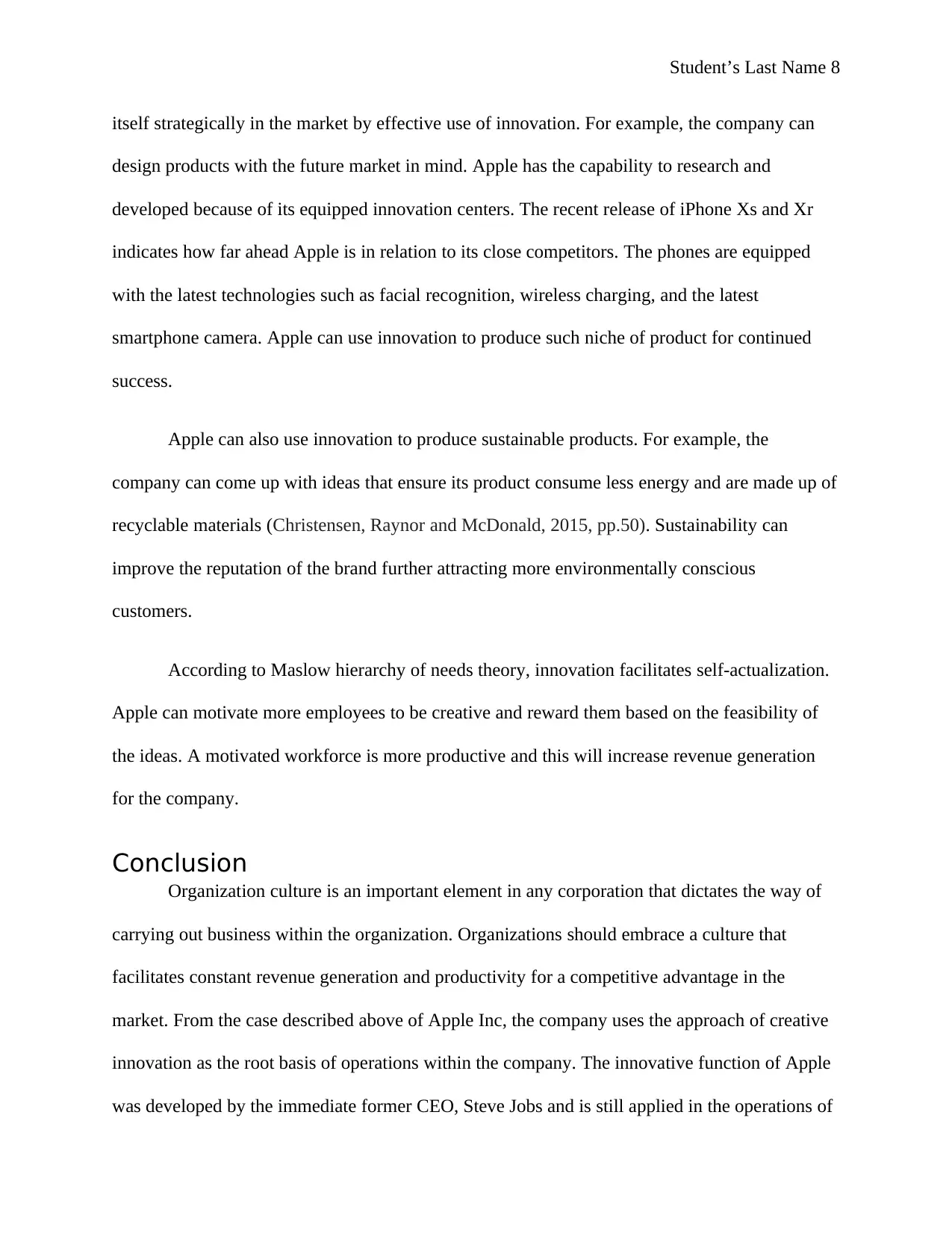
Student’s Last Name 8
itself strategically in the market by effective use of innovation. For example, the company can
design products with the future market in mind. Apple has the capability to research and
developed because of its equipped innovation centers. The recent release of iPhone Xs and Xr
indicates how far ahead Apple is in relation to its close competitors. The phones are equipped
with the latest technologies such as facial recognition, wireless charging, and the latest
smartphone camera. Apple can use innovation to produce such niche of product for continued
success.
Apple can also use innovation to produce sustainable products. For example, the
company can come up with ideas that ensure its product consume less energy and are made up of
recyclable materials (Christensen, Raynor and McDonald, 2015, pp.50). Sustainability can
improve the reputation of the brand further attracting more environmentally conscious
customers.
According to Maslow hierarchy of needs theory, innovation facilitates self-actualization.
Apple can motivate more employees to be creative and reward them based on the feasibility of
the ideas. A motivated workforce is more productive and this will increase revenue generation
for the company.
Conclusion
Organization culture is an important element in any corporation that dictates the way of
carrying out business within the organization. Organizations should embrace a culture that
facilitates constant revenue generation and productivity for a competitive advantage in the
market. From the case described above of Apple Inc, the company uses the approach of creative
innovation as the root basis of operations within the company. The innovative function of Apple
was developed by the immediate former CEO, Steve Jobs and is still applied in the operations of
itself strategically in the market by effective use of innovation. For example, the company can
design products with the future market in mind. Apple has the capability to research and
developed because of its equipped innovation centers. The recent release of iPhone Xs and Xr
indicates how far ahead Apple is in relation to its close competitors. The phones are equipped
with the latest technologies such as facial recognition, wireless charging, and the latest
smartphone camera. Apple can use innovation to produce such niche of product for continued
success.
Apple can also use innovation to produce sustainable products. For example, the
company can come up with ideas that ensure its product consume less energy and are made up of
recyclable materials (Christensen, Raynor and McDonald, 2015, pp.50). Sustainability can
improve the reputation of the brand further attracting more environmentally conscious
customers.
According to Maslow hierarchy of needs theory, innovation facilitates self-actualization.
Apple can motivate more employees to be creative and reward them based on the feasibility of
the ideas. A motivated workforce is more productive and this will increase revenue generation
for the company.
Conclusion
Organization culture is an important element in any corporation that dictates the way of
carrying out business within the organization. Organizations should embrace a culture that
facilitates constant revenue generation and productivity for a competitive advantage in the
market. From the case described above of Apple Inc, the company uses the approach of creative
innovation as the root basis of operations within the company. The innovative function of Apple
was developed by the immediate former CEO, Steve Jobs and is still applied in the operations of
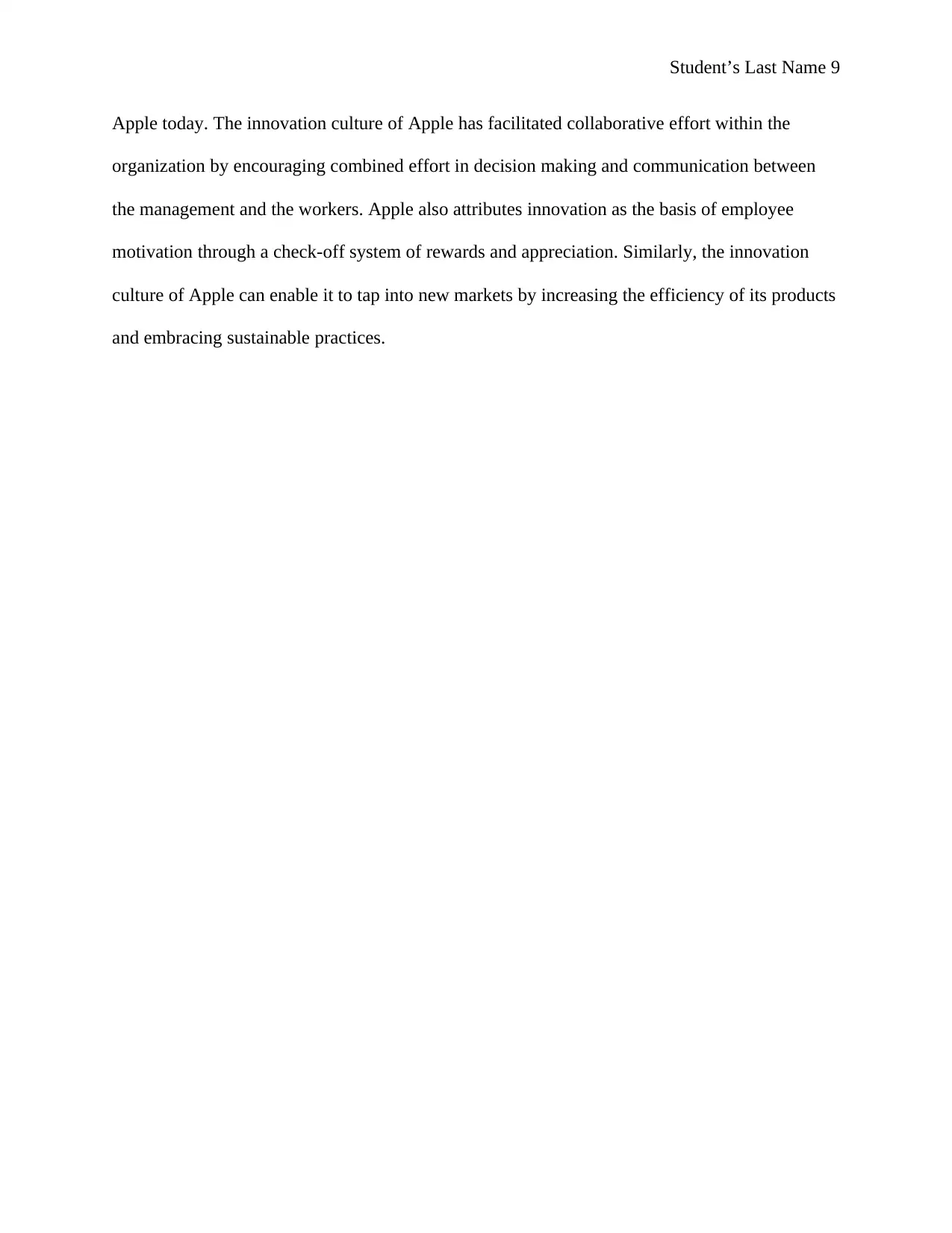
Student’s Last Name 9
Apple today. The innovation culture of Apple has facilitated collaborative effort within the
organization by encouraging combined effort in decision making and communication between
the management and the workers. Apple also attributes innovation as the basis of employee
motivation through a check-off system of rewards and appreciation. Similarly, the innovation
culture of Apple can enable it to tap into new markets by increasing the efficiency of its products
and embracing sustainable practices.
Apple today. The innovation culture of Apple has facilitated collaborative effort within the
organization by encouraging combined effort in decision making and communication between
the management and the workers. Apple also attributes innovation as the basis of employee
motivation through a check-off system of rewards and appreciation. Similarly, the innovation
culture of Apple can enable it to tap into new markets by increasing the efficiency of its products
and embracing sustainable practices.
⊘ This is a preview!⊘
Do you want full access?
Subscribe today to unlock all pages.

Trusted by 1+ million students worldwide
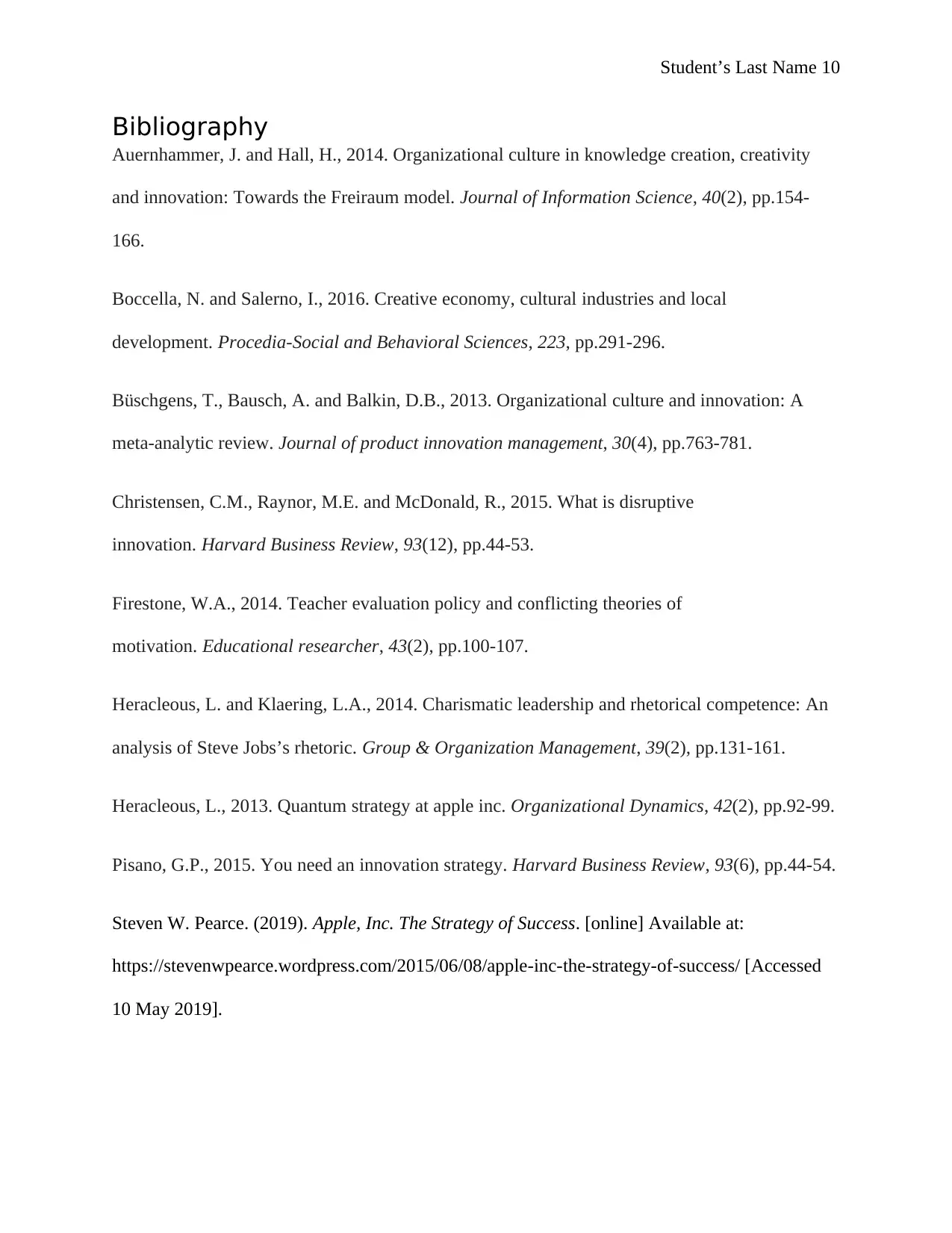
Student’s Last Name 10
Bibliography
Auernhammer, J. and Hall, H., 2014. Organizational culture in knowledge creation, creativity
and innovation: Towards the Freiraum model. Journal of Information Science, 40(2), pp.154-
166.
Boccella, N. and Salerno, I., 2016. Creative economy, cultural industries and local
development. Procedia-Social and Behavioral Sciences, 223, pp.291-296.
Büschgens, T., Bausch, A. and Balkin, D.B., 2013. Organizational culture and innovation: A
meta‐analytic review. Journal of product innovation management, 30(4), pp.763-781.
Christensen, C.M., Raynor, M.E. and McDonald, R., 2015. What is disruptive
innovation. Harvard Business Review, 93(12), pp.44-53.
Firestone, W.A., 2014. Teacher evaluation policy and conflicting theories of
motivation. Educational researcher, 43(2), pp.100-107.
Heracleous, L. and Klaering, L.A., 2014. Charismatic leadership and rhetorical competence: An
analysis of Steve Jobs’s rhetoric. Group & Organization Management, 39(2), pp.131-161.
Heracleous, L., 2013. Quantum strategy at apple inc. Organizational Dynamics, 42(2), pp.92-99.
Pisano, G.P., 2015. You need an innovation strategy. Harvard Business Review, 93(6), pp.44-54.
Steven W. Pearce. (2019). Apple, Inc. The Strategy of Success. [online] Available at:
https://stevenwpearce.wordpress.com/2015/06/08/apple-inc-the-strategy-of-success/ [Accessed
10 May 2019].
Bibliography
Auernhammer, J. and Hall, H., 2014. Organizational culture in knowledge creation, creativity
and innovation: Towards the Freiraum model. Journal of Information Science, 40(2), pp.154-
166.
Boccella, N. and Salerno, I., 2016. Creative economy, cultural industries and local
development. Procedia-Social and Behavioral Sciences, 223, pp.291-296.
Büschgens, T., Bausch, A. and Balkin, D.B., 2013. Organizational culture and innovation: A
meta‐analytic review. Journal of product innovation management, 30(4), pp.763-781.
Christensen, C.M., Raynor, M.E. and McDonald, R., 2015. What is disruptive
innovation. Harvard Business Review, 93(12), pp.44-53.
Firestone, W.A., 2014. Teacher evaluation policy and conflicting theories of
motivation. Educational researcher, 43(2), pp.100-107.
Heracleous, L. and Klaering, L.A., 2014. Charismatic leadership and rhetorical competence: An
analysis of Steve Jobs’s rhetoric. Group & Organization Management, 39(2), pp.131-161.
Heracleous, L., 2013. Quantum strategy at apple inc. Organizational Dynamics, 42(2), pp.92-99.
Pisano, G.P., 2015. You need an innovation strategy. Harvard Business Review, 93(6), pp.44-54.
Steven W. Pearce. (2019). Apple, Inc. The Strategy of Success. [online] Available at:
https://stevenwpearce.wordpress.com/2015/06/08/apple-inc-the-strategy-of-success/ [Accessed
10 May 2019].
Paraphrase This Document
Need a fresh take? Get an instant paraphrase of this document with our AI Paraphraser
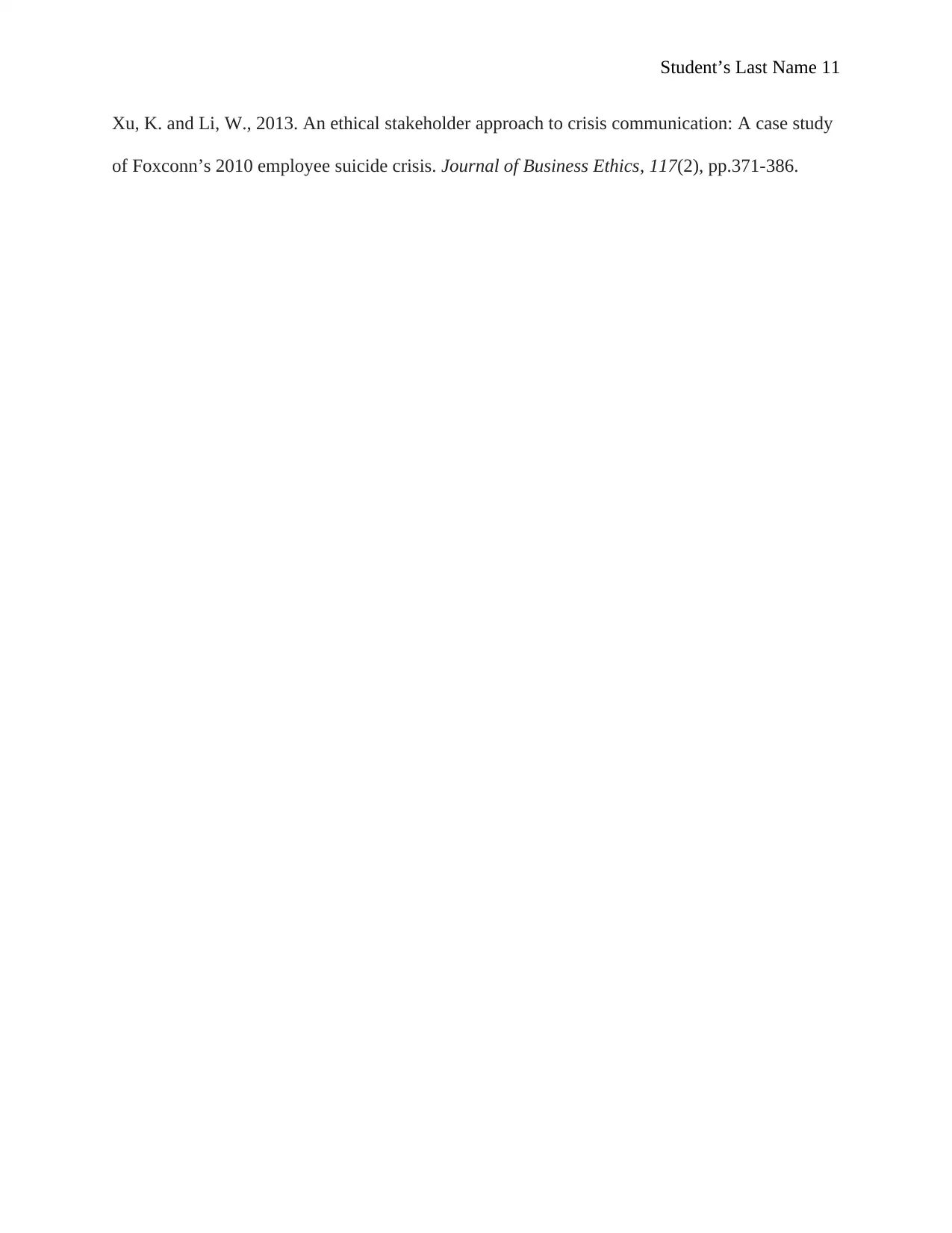
Student’s Last Name 11
Xu, K. and Li, W., 2013. An ethical stakeholder approach to crisis communication: A case study
of Foxconn’s 2010 employee suicide crisis. Journal of Business Ethics, 117(2), pp.371-386.
Xu, K. and Li, W., 2013. An ethical stakeholder approach to crisis communication: A case study
of Foxconn’s 2010 employee suicide crisis. Journal of Business Ethics, 117(2), pp.371-386.
1 out of 11
Related Documents
Your All-in-One AI-Powered Toolkit for Academic Success.
+13062052269
info@desklib.com
Available 24*7 on WhatsApp / Email
![[object Object]](/_next/static/media/star-bottom.7253800d.svg)
Unlock your academic potential
Copyright © 2020–2025 A2Z Services. All Rights Reserved. Developed and managed by ZUCOL.





